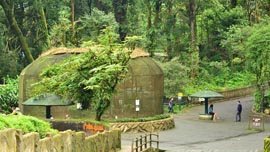Darjeeling
Darjeeling in India owes' its grandeur to its natural beauty, its clean fresh mountain air and above all, the smiling resilient people for whom it is a home. Known for its natural splendor, Darjeeling's best gift to its' visitors is the dawn of a new day. The mountains awaken first with a tentative peeking of the sun. A steep ride, five kilometers from Ghoom, or an invigorating walk up a steep incline, leads sun worshippers to Tiger Hill. The air is chilly with darkness and damp. To the east, a dull orange sun emerged painting the sky with brilliant strokes of magenta, gold, orange and fuchsia. The snow capped Everest, Kabru, Kanchenjunga, Jannu and other peaks slowly emerge from slumber to start a new day. The sun worshippers gasp at the magnificent sight. As the fog lifts in the slowly penetrating sun, the town gradually comes alive. Amidst brewing of tea, the sing-song Gorkhali which is the local dialect, rises and falls like music.
TOURIST DESTINATIONS OF DARJEELING
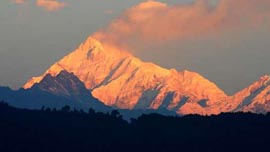
Tiger Hill
Tiger Hill is the summit of Ghoom, the highest railway station on the Darjeeling Himalayan Railway - a UNESCO World Heritage Site. It is famous for spectacular sunrise show over the Himalaya. Leveling out at 8,500 ft (2,600 m), Tiger Hill is the highest hill in the immediate surroundings. It is 11 km from town of Darjeeling and can be reached either by jeep or by foot through Chowrasta, Alubari (incidentally the oldest tea plantation in Darjeeling) Jore Bungla and then the incline up to the summit, which takes about 2 hours on an easy gait.
Situated at an altitude of 2590 meters (8482 ft.) and 13 kilometers from the town, this spot has earned international fame for the magnificent view of the sunrise over the "Kanchanjunga" and the great eastern Himalayan Mountains. Even Mount Everest, the world's highest peak, is visible from here. The hesitant rays of the early morning sun paint these peaks in pale gold.
Batasia Loop and the War Memorial
This railway loop is an interesting example of engineering feat, which was constructed with the purpose of allowing the toy train to take the sharp drop in altitude between Ghoom and Darjeeling, with ease. From Darjeeling station joy rides in the toy train can be availed of to Batasia Loop and back.
A war memorial was constructed in the space within the loop in 1994. There is also a 30 ft. high triangular cenotaph with the Roll of Honour engrave on it. It is an fascinating experience to watch the toy train negotiating the loop through the well manicured gardens of flowers with Kanchenjunga and Darjeeling town in background.

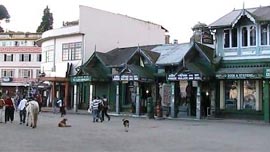
Chowrasta and Mall
Chowrasta in Darjeeling is a spread around a large, open and asphalted area, surrounded with shops, small and big restaurants, cafeterias and pony stables. Chowrasta at Darjeeling is situated at a good height from the low lying areas and offers breath takingly beautiful views of the mountains. People can take leisurely horse rides here and take a few rounds of the Darjeeling Chowrasta.
Just at one end of the plaza, one can spot ladies gathered in groups and chatting away to glory. Along one side of the Chowrasta of Darjeeling, one will spot the Oxford Bookstore and Habeeb Mullick. While the Oxford has all the books one could ask for, the Habeeb Mullick store is quite famous for the metallic artifacts.
Rock Garden and Ganga Maya Park
Situated 10 km from town, Rock Garden and Ganga Maya Park has now developed into a very attractive picnic spot with natural water falls. The park offers boating facilities and is endowed with great scenic beauty. Ample eateries are available for visitors to indulge in local delicacies and one can even buy souvenirs. No fees are charged for taking photographs. Visitors are however, required to make arrangements for transportation. A two way travel arrangement is advisable.
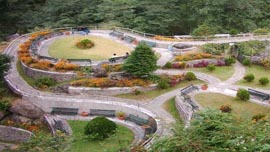

Peace Pagoda
The building of the Peace Pagoda was intiated by Fuji Guru, the founder of the Nipponzan Myhoji Buddhist Order and a close friend of Mahatma Gandhi, as a symbol for world peace. The sparkling white pagoda rises 28.5 metres from the ground level and has a diameter of 23mts. Embedded in the wall of the pagoda are four statues of Buddha in gold polish and eight carvings on sandstone depicting different stages of Gautam Buddha's life.
The Buddhist temple is located near the peace pagoda and is designed in traditional Japanese style. Photography is allowed inside the temple but the Japanese monks will ask you not to enter during prayers.
Nightingale Park/Srubbery Park
Shrubbery Nightingale Park used to be the private courtyard of Sir Thomas Tartan's bungalow during the British rule and was simply referred to as "The Shrubbery". This park became public after it was completely destroyed in the earthquake of 1934 and was popular with British women for their tea parties.
During the 1950s and 60s, Shrubbery Nightingale Park was a much sought-after location for Bollywood films but was grossly neglected during the 1980s and early 90s. Sense prevailed and the Shrubbery Nightingale Park was restored. At present, it is home to a giant Lord Shiva statue along with a related temple and a live music stage. The music fountain is one of the main attractions of the park. The best time to visit the park is in the evening. A minimal fee is charged for entry and photography.
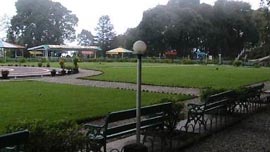
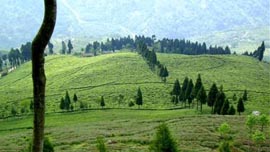
Mirik
Mirik is a picturesque tourist spot nestled in the serene hills of the district of Darjeeling, and the drive in itself is breathtaking. As you wind your way down from Darjeeling you are surrounded by lush green tea gardens with the majestic backdrop of the Kanchunga range. With its pleasant climate, breathtaking natural beauty and easy accessibility, Mirik has become a popular tourist destination Mirik provides the perfect soothing balm to tired minds and bodies and a day spent here is said to invigorate one with spiritual and natural energy.
The centre of attraction is the Sumendu lake surrounded by a beautiful garden on one side and pine forests on the other, linked together by an arching footbridge. A 3.5-km-long road encircles the lake and is ideal for pleasant walks with the magnificent view of Kanchenjunga on the far horizon. Boating on the quaint shikaras and pony riding are enjoyable.
Padmaja Naidu Himalayan Zoological Park
Established on the 14th of August, 1958, the zoo was dedicated to the memory of Padmaja Naidu, former Governor of West Bengal on the 21st November, 1975. Considered as one of the best zoos in the country, it is the only centre that breeds the tibetan wolf in captivity. Breeding programmes for the endangered red panda, snow leopard and the siberian tiger are also carried out at PNHZP. The zoo is open on all days except on Thursdays and other national holidays.
Located below Himalayan Mountaineering Institute, on the slopes of Jawahar Parbhat, Padmaja Naidu Himalayan Zoological Park of Darjeeling is a 'one of its kinds' park in the entire West Bengal. It is situated at an elevation of 2133.5 meter and spread over an area of 44 hectares.
